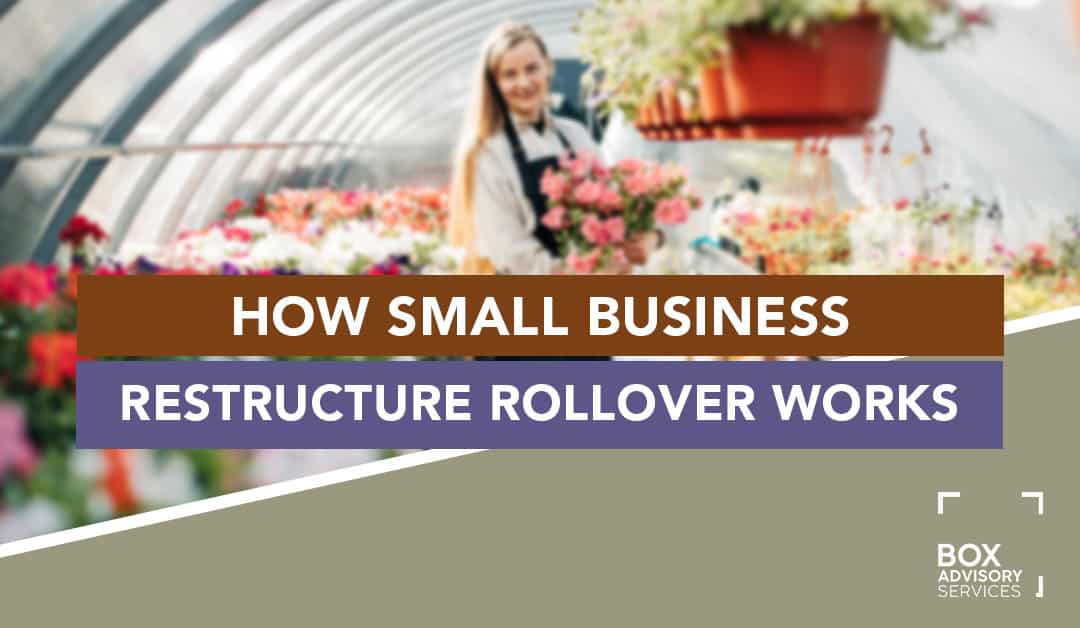
BY
|
What You Need to Know About The Small Business Rollover
Since 1 July 2016, the Australian government has made several tax concessions available through the Small Business Restructure Rollover, offering smaller businesses the chance to undergo restructuring changes without facing tax issues.
The small business restructure rollover offers significant benefits to small businesses restructuring their affairs. Understanding the tax consequences is crucial for small businesses considering restructuring, as they affect their financial planning and compliance with Australian tax laws.
However, the Australian Tax Office (ATO) enforces strict guidelines and eligibility criteria.
So, we’ve put together this guide to help you navigate the small business rollover so that you can effectively minimise your tax liability.
What Is the Small Business Restructure Rollover?
The objective behind introducing the small business restructure rollover (SBRR) is to allow flexibility for small business owners who want to restructure their businesses.
The SBRR framework essentially allows small businesses to transfer active assets to the new business entity without triggering an income tax liability.
In other words, the small business can disregard any capital gain made on the transfer of their active assets into the new entity structure.
What Are Eligible Active Assets?
Active assets are assets that your business holds to carry out the objectives of that business entity, and they include:
- capital gains tax assets,
- revenue assets,
- trading stock, and
- depreciating assets.
So, assets such as shareholder loans are not considered active because they are not used in the course of conducting business.
However, unlike other business rollover tax concessions, the ATO proposes a specific requirement that the small business restructure rollover must be considered a genuine transaction.
In other words, if the restructuring is occurring simply to access the tax concessions (i.e. a tax-driven scheme), the transaction won’t be considered genuine, and the rollover benefits won’t apply.
When Is the Small Business Restructure Rollover Applicable?
According to the Law Companion Ruling, the ATO may consider the following attributes as a demonstration of a genuine restructure:
- the rollover is taking place in good faith, and to enhance business efficiency,
- the business operations continue in the new entity structure,
- the transferred assets continue to be of use to the new entity structure,
- the small business obtained the necessary professional advice before and during the restructuring process,
- there is substantial evidence to prove that the restructuring is not tax-driven, and
- the restructuring isn’t used to promote the disposal of any business assets outside the business entity.
Suppose a small business has chosen to simplify its operations from a company owned by a family trust to a sole trader structure where the small business owner personally holds the assets. In that case, the restructuring is considered genuine because the sole trader structure allows for a reduction in operation costs and ongoing business, for example.
What is the Safe Harbour Rule, and How Does it Apply?
The SRBB laws and regulations include a ‘safe harbour’ rule to provide certainty to small businesses.
The rule outlines that a small business will have satisfied the genuine restructure requirement, if, for three years after the rollover:
- there is no change in the ultimate economic ownership of any of the significant assets of the business (other than trading stock) that were transferred;
- those significant assets continue to be active assets; and
- there is no significant or material use of those significant assets for private purposes.
If a small business owner has restructured their affairs for the sole purpose of facilitating a tax-effective sale of the business a few months later, that would not be a genuine restructure.
This is because the small business owner had no intention of carrying ongoing business in the new entity.
Who Can Claim the Small Business Restructure Rollover?
Further eligibility requirements include:
- both entities must each elect to apply the rollover, and
- both entities (the current entity and the new business entity) must be small business entities.
A small business entity can be either one of the following:
- a small business entity with an annual turnover that’s less than $10 million,
- an entity that has an affiliate that is a small business entity,
- an entity that is connected with a small business entity, and
- a partner in a partnership that is a small business entity.
So, a holding company (an entity holding assets for the small business entity) can apply for the rollover relief, for example.
What Are The Tax Implications of the Small Business Restructure Rollover?
If the restructuring of your small business entity satisfies all the eligibility criteria, and you choose to access the SBRR, then the new business structure will take over the ownership of the assets at their tax cost, and no gain (or loss) will arise.
This means that:
- pre-capital gains tax assets (i.e. assets acquired before 20 September 1985) retain their status and will be exempt from CGT on their eventual sale;
- post-capital gains tax assets (i.e. assets acquired after 20 September 1985) will be considered as acquired on the date of the transfer (so, to qualify for the 50% active asset reduction, the new entity will have to hold the asset for 12 months from the date of transfer);
- access to the 15-year exemption in the small business CGT concessions is not affected;
- the cost of the trading stock (the opening value of that stock ) is the applicable rate at the date of transfer;
- revenue assets take the cost which will result in no profit or loss to the new business entity; and
- depreciating assets inherit the written-down value of the assets and continue to depreciate in the same manner.
Key Takeaways
- The small business restructure rollover is designed to give small businesses more flexibility in changing their business structures without triggering a significant tax liability.
- While the tax advantages can be significant, the ATO has implemented strict guidelines and regulations for the process.
- For example, there must be a genuine intention to restructure the business. So, if you’re restructuring the business specifically to create a more tax-effective sale, then your small business entity won’t qualify for the small business rollover relief.
- So there’s a lot to consider – especially when it comes to the purpose of the restructure, the type of assets involved in the transfer and the structure of the new business entity.
- When establishing whether a restructuring is genuine, the ATO will look to see if a financial advisor aided in the decision-making process to restructure.
- So, if you would like to know more about business restructuring and determine your eligibility to apply for the small business restructure rollover, get in touch with us at Box Advisory Services today.
- We’re a team of expert tax accountants looking to help small business owners and contractors make better decisions for their businesses.
Whether you need a tax accountant or a small business advisor, book a free consultation so that we can assess your situation.
Disclaimer:
Please note that every effort has been made to ensure that the information provided in this guide is accurate. You should note, however, that the information is intended as a guide only, providing an overview of general information available to property buyers and investors. This guide is not intended to be an exhaustive source of information and should not be seen to constitute legal, tax or investment advice. You should, where necessary, seek your own advice for any legal, tax or investment issues raised in your affairs.



